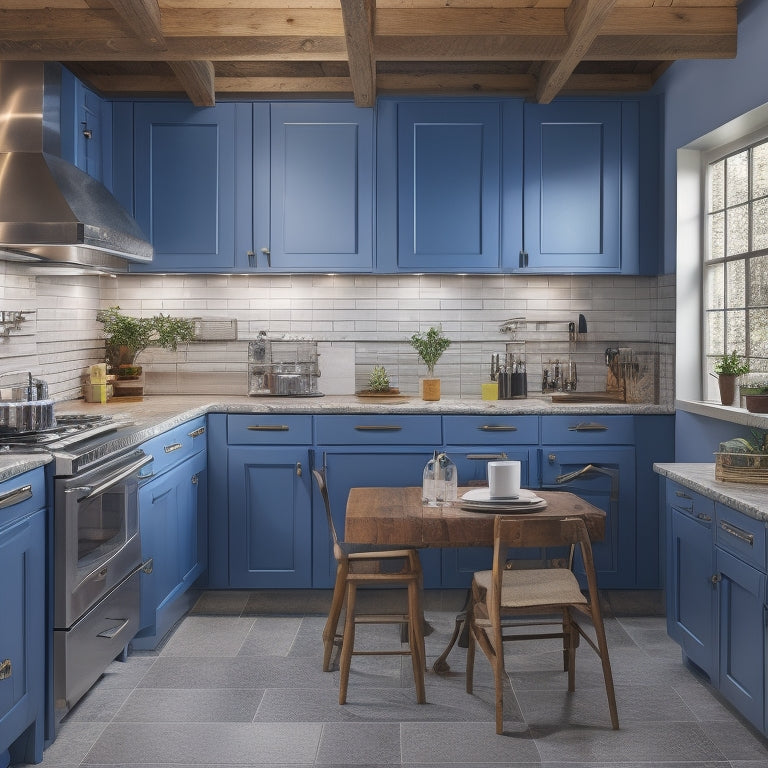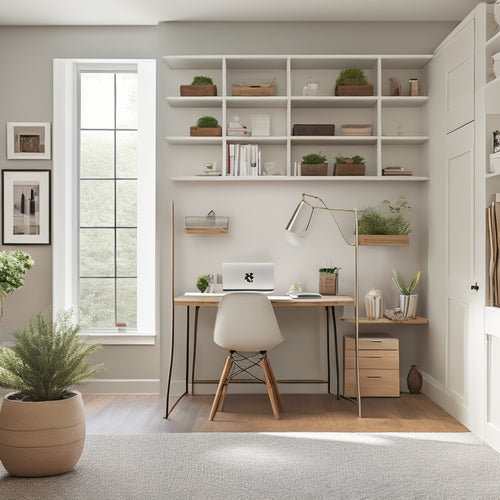
Master Your Home Remodeling Project With Tips
Share
To master your home remodeling project, start by laying a strong foundation through careful planning, contractor selection, and permit acquisition. Next, establish a realistic budget and plan the layout, materials, and design that align with your vision and lifestyle. Effectively allocate your budget, prioritize needs, and plan for contingencies to guarantee a smooth execution. Meticulous attention to detail and timeline management are vital during installation. Finally, focus on final touches, adding personal style and flair, and celebrate your newly transformed space. With a thorough approach, you'll be well on your way to achieving a successful and stress-free remodel.
Key Takeaways
• Establish a strong foundation by selecting the right contractor and addressing permit requirements to prevent delays and fines.
• Plan effectively by setting a realistic budget, selecting materials and finishes, and exploring color schemes that reflect your personality.
• Allocate your budget wisely by identifying cost-saving opportunities, planning for contingencies, and prioritizing remodeling needs.
• Ensure a smooth execution by coordinating with your contractor, paying attention to detail, and addressing concerns promptly.
• Focus on final touches by adding home accessories, hiring a professional cleaning service, and showcasing your new space with a celebratory gathering.
Laying the Foundation
Establishing a strong foundation is crucial to guaranteeing the success of your home remodeling project, and it begins with two critical components: choosing the right contractor and selecting a style that aligns with your vision and budget.
A reliable contractor will make certain that your project meets structural integrity standards, while a well-chosen style will guide design decisions and prevent costly changes down the line.
Don't forget to address permit requirements early on to prevent delays and fines. By laying a solid foundation, you'll set yourself up for a smooth and successful remodel.
Design and Planning
Three essential elements form the backbone of a successful home remodeling project's design and planning phase:
- Establishing a realistic budget
- Planning the layout
- Selecting materials and finishes that align with your vision and lifestyle.
A well-planned design scheme can elevate your remodel from ordinary to extraordinary.
Start by exploring color schemes that reflect your personality and complement your home's architecture.
Next, consider furniture selection that not only fits your space but also serves your functional needs.
Then, immerse yourself in the world of materials and finishes, balancing durability, maintenance, and aesthetics.
Budgeting and Preparation
As you move forward with your home remodeling project, a thorough understanding of budgeting and preparation is essential to ensuring that your design vision becomes a reality without breaking the bank. A well-planned budget will help you prioritize your remodeling needs, identify cost-saving opportunities, and avoid unnecessary upgrades or changes.
To prepare financially, consider the following:
- Develop cost-saving strategies, such as repurposing materials or shopping for discounts
- Allocate your budget effectively, dividing it into categories like labor, materials, and contingency funds
- Plan for contingencies, setting aside 10-20% of your budget for unexpected expenses
- Prioritize your remodeling needs, focusing on the most essential aspects of your project
Execution and Installation
With a well-planned budget and design in place, the execution and installation phase of your home remodeling project is where your vision begins to take shape, requiring careful coordination and attention to detail to bring your dream to life. This critical phase demands meticulous contractor selection, ensuring quality assurance and a smooth workflow.
Effective timeline management is essential, allowing for efficient subcontractor coordination and minimizing delays. By prioritizing quality assurance, you can rest assured that every aspect of your remodel meets your expectations.
Stay vigilant, and don't hesitate to address any concerns that arise during this phase. With careful planning and execution, your home remodeling project will transform into a stunning reality.
Final Touches and Completion
As the execution and installation phase comes to a close, it's time to focus on the final touches that will elevate your remodel from mere renovation to stunning reality. This stage is where meticulous attention to detail and quality assurance are paramount.
To guarantee a flawless finish, consider the following essential tasks:
-
Add home accessories that reflect your personal style and tie in with your new design
-
Hire a professional cleaning service to give your home a sparkling clean finish
-
Add landscaping touches, such as plants or outdoor decor, to complete your home's exterior
- Host a celebratory gathering to showcase your new space and share the excitement with friends and family
Frequently Asked Questions
What if I Want to Make Changes to the Original Design Plan?
According to a study, 60% of homeowners make changes to their original design plan during a remodeling project. This is where design flexibility comes in.
If you want to make changes, discuss them with your contractor to determine the impact on the project timeline and budget. Be prepared for potential change orders, which can add costs and delay completion.
Prioritize your changes and communicate effectively to minimize disruptions and guarantee a successful outcome.
Can I Live in the House During the Remodeling Process?
Living in the house during a remodeling process can be challenging, but it's not impossible.
Consider Temporary Accommodations, such as renting a nearby apartment or setting up a temporary kitchen in the garage.
Alternatively, opt for a Phased Renovation, where you renovate one area at a time, allowing you to still occupy the rest of the house.
This approach requires careful planning, but it can minimize disruptions and make the process more manageable.
How Do I Handle Unexpected Damage or Hidden Issues?
The remodeling revelation: uncovering hidden issues that can turn your dream project into a nightmare. Fear not, dear homeowner, for we've got a plan to tackle the unexpected.
When damage or hidden issues arise, remain calm and contact your contractor immediately. Review your insurance policy to determine coverage for unexpected claims.
Guarantee a thorough assessment of the issue, prioritizing structural integrity to ensure a safe and sturdy dwelling.
What Kind of Warranty or Guarantee Can I Expect From Contractors?
When vetting contractors, it's crucial to inquire about warranties and guarantees. A reputable contractor should offer a thorough warranty that covers workmanship, materials, and labor for a specified period.
Look for contractors who stand behind their work and provide a minimum of a one-year warranty. Additionally, make sure that the warranty covers material quality, as high-quality materials can greatly impact the project's overall success.
How Do I Maintain or Repair New Features After the Project Is Complete?
To guarantee your newly remodeled features remain in top condition, prioritize regular maintenance and schedule seasonal checkups. This includes tasks like cleaning filters, inspecting seals, and lubricating moving parts.
Create a maintenance calendar to stay on track, and consider setting aside a small budget for annual upkeep. By being proactive, you'll prevent minor issues from becoming major headaches, and extend the lifespan of your new features.
Related Posts
-

Optimize Your Small Home Office With Smart Storage
You can instantly boost your productivity and reduce stress by optimizing your small home office with smart storage s...
-

Top Digital Tools for Home Decor Organization
You're looking to take your home decor organization to the next level with the right digital tools. From cloud storag...

